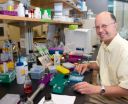(Press-News.org) The base pairs that hold together two pieces of RNA, the older cousin of DNA, are some of the most important molecular interactions in living cells. Many scientists believe that these base pairs were part of life from the very beginning and that RNA was one of the first polymers of life. But there is a problem. The RNA bases don't form base pairs in water unless they are connected to a polymer backbone, a trait that has baffled origin-of-life scientists for decades. If the bases don't pair before they are part of polymers, how would the bases have been selected out from the many molecules in the "prebiotic soup" so that RNA polymers could be formed?
Researchers at the Georgia Institute of Technology are exploring an alternate theory for the origin of RNA: they think the RNA bases may have evolved from a pair of molecules distinct from the bases we have today. This theory looks increasingly attractive, as the Georgia Tech group was able to achieve efficient, highly ordered self-assembly in water with small molecules that are similar to the bases of RNA. These "proto-RNA bases" spontaneously assemble into gene-length linear stacks, suggesting that the genes of life could have gotten started from these or similar molecules. The research is published online in the Journal of the American Chemical Society.
The discovery was made by a team of scientists led by Georgia Tech Professor Nicholas Hud, who has been trying for years to find simple molecules that will assemble in water and be capable of forming RNA or its ancestor. Hud's group knew that they were on to something when they added a small chemical tail to a proto-RNA base and saw it spontaneously form linear assemblies with another proto-RNA base. In some cases, the results produced 18,000 nicely ordered, stacked molecules in one long structure.
"Thinking about the origin of RNA reminds me of the paradox of your grandfather's ax," said Hud, a professor in the School of Chemistry and Biochemistry. "If your father changed the handle and you changed the head, is it the same ax? We see RNA the same way. Its chemical structure might have changed over time, but it was in continual use so we can consider it to be the same molecule."
Hud concedes that scientists may never be 100 percent sure what existed four billion years ago when a complex mixture of chemicals started to work together to start life. His next goal is to determine whether the proto-RNA bases can be linked by a backbone to form a polymer that could have functioned as a genetic material.
Georgia Tech partnered with the Institute for Research in Biomedicine in Barcelona, Spain on the project. The proto-RNA's two-component, self-assembling system consisted of cyanuric acid (CA) and TAPAS, a derivative of triaminopyrimidine (TAP).
In addition to addressing the origin-of-life questions, Hud suggests the self-assembly process could be used in the future to create new materials, such as nanowires.
INFORMATION:
This project is supported by the National Science Foundation (NSF) and NASA (Award Number CHE-1004570), and by NASA Exobiology (Award Number NNX08A014G). The content is solely the responsibility of the principal investigators and does not necessarily represent the official views of the NSF or NASA.
Molecules assemble in water, hint at origins of life
2013-02-20
ELSE PRESS RELEASES FROM THIS DATE:
Being stoic for the spouse's sake comes at a high cost
2013-02-20
Among life's many tragedies, the death of a child is one that is perhaps the greatest for parents. No matter what the age of the child or the cause of death, the irrefutable fact of the loss is one that shatters the normal cycle of life, leaving parents traumatized and often incapacitated by grief.
Research on coping with bereavement has focused primarily on the individual, despite the fact that family and married relationships are all profoundly disrupted by the loss. But in the wealth of studies about parental grief, little attention has been paid to precisely how couples ...
Study: Resveratrol shows promise to protect hearing, cognition
2013-02-20
DETROIT – Resveratrol, a substance found in red grapes and red wine, may have the potential to protect against hearing and cognitive decline, according to a published laboratory study from Henry Ford Hospital in Detroit.
The study shows that healthy rats are less likely to suffer the long-term effects of noise-induced hearing loss when given resveratrol before being exposed to loud noise for a long period of time.
"Our latest study focuses on resveratrol and its effect on bioinflammation, the body's response to injury and something that is believed to be the cause of ...
Children with brain lesions able to use gestures important to language learning
2013-02-20
ATLANTA – Children with brain lesions suffered before or around the time of birth are able to use gestures – an important aspect of the language learning process– to convey simple sentences, a Georgia State University researcher has found.
Şeyda Özçalışkan, assistant professor of psychology, and fellow researchers at the University of Chicago, looked at children who suffered lesions to one side of the brain to see whether they used gestures similar to typically developing children. She examined gestures such as pointing to a cookie while saying "eat" to ...
The ethics of access: Comparing 2 federal health care reform efforts
2013-02-20
ANN ARBOR, Mich. — Two major health reform laws, enacted 25 years apart, both try to meet an ethical standard to provide broad access to basic health care. Neither quite gets there -- but it's not too late for modern health care reform to bring the nation closer to a goal of comprehensive and coordinated care for all.
That's the conclusion of a commentary published in the new issue of the Journal of the American Medical Association by a team of University of Michigan Health System physicians.
The authors – a family physician, an emergency physician and a primary care ...
Smoking cessation in old age: Less heart attacks and strokes within 5 years
2013-02-20
Professor Hermann Brenner and colleagues analyzed the data of 8.807 individuals aged between 50 and 74 years using data of Saarland citizens. "We were able to show that the risk of smokers for cardiovascular diseases is more than twice that of non-smokers. However, former smokers are affected at almost the same low rate as people of the same age who never smoked," says Brenner. "Moreover, smokers are affected at a significantly younger age than individuals who have never smoked or have stopped smoking." For example, a 60-year-old smoker has the same risk of myocardial infarction ...
Setting the record straight on Medicare's overhead costs: New study
2013-02-20
The traditional Medicare program allocates only 1 percent of total spending to overhead compared with 6 percent when the privatized portion of Medicare, known as Medicare Advantage, is included, according to a study in the June 2013 issue of the Journal of Health Politics, Policy and Law.
The 1 percent figure includes all types of non-medical spending by the Centers for Medicare and Medicaid Services plus other federal agencies, such as the IRS, that support the Medicare program, and is based on data contained in the latest report of the Medicare trustees. The 6 percent ...
MIT researchers build Quad HD TV chip
2013-02-20
CAMBRIDGE, MA -- It took only a few years for high-definition televisions to make the transition from high-priced novelty to ubiquitous commodity — and they now seem to be heading for obsolescence just as quickly. At the Consumer Electronics Show (CES) in January, several manufacturers debuted new ultrahigh-definition, or UHD, models (also known as 4K or Quad HD) with four times the resolution of today's HD TVs.
In addition to screens with four times the pixels, however, UHD also requires a new video-coding standard, known as high-efficiency video coding, or HEVC. Also ...
Gains made towards treatment of rare bone disease
2013-02-20
This press release is available in French.
Diagnosed in toddlers, X-linked hypophosphatemia (XLH) is the most common form of heritable rickets, in which soft bones bend and deform, and tooth abscesses develop because infections penetrate soft teeth that are not properly calcified. Researchers at McGill University and the Federal University of Sao Paulo have identified that osteopontin, a major bone and tooth substrate protein, plays a role in XLH. Their discovery may pave the way to effectively treating this rare disease.
The findings were made by the laboratories ...
Searching for the solar system's chemical recipe
2013-02-20
By studying the origins of different isotope ratios among the elements that make up today's smorgasbord of planets, moons, comets, asteroids, and interplanetary ice and dust, Mark Thiemens and his colleagues hope to learn how our solar system evolved. Thiemens, Dean of the Division of Physical Sciences at the University of California, San Diego, has worked on this problem for over three decades.
In recent years his team has found the Chemical Dynamics Beamline of the Advanced Light Source (ALS) at the U.S. Department of Energy's Lawrence Berkeley National Laboratory ...
Handheld device for detecting counterfeit and substandard medicines tested by PQM
2013-02-20
Rockville, Md., February 13, 2013 – With substandard and counterfeit medicines a dangerous and growing problem in the developing world and elsewhere, identifying new technologies to detect such drugs is an urgent matter. In a new study published in the Journal of Pharmaceutical and Biomedical Analysis, scientists from the U.S. Pharmacopeial Convention (USP) evaluated a handheld Raman device's potential to detect counterfeit and substandard medicines. The device, called TruScan®, is currently used to test Active Pharmaceutical Ingredients (API) and finished pharmaceutical ...

